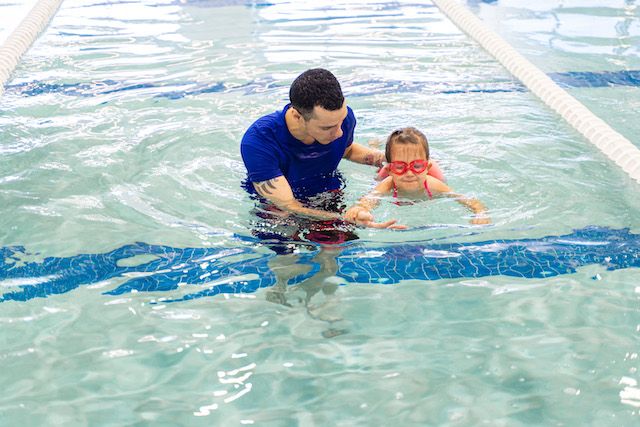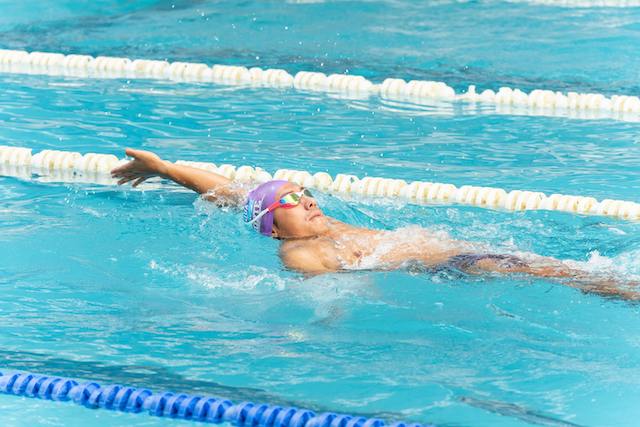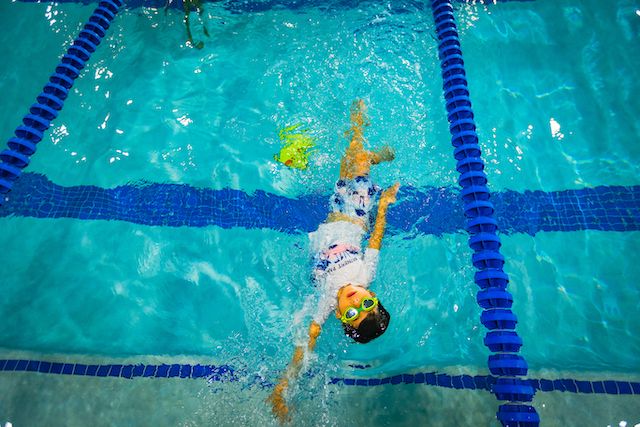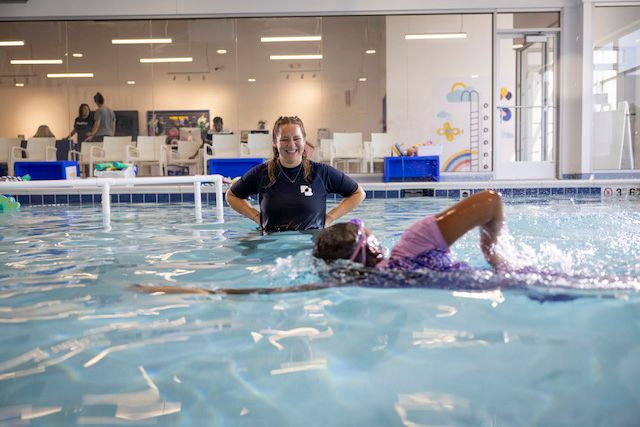Learning the Different Types of Swimming Strokes
Once you have helped your child acclimate to water and introduced them to basic water safety skills, it’s time to explore the different swimming strokes.
Learning each stroke lets your child discover which swimming style works best for their body. Proper technique keeps kids safe in the water, whether they are beginners or more experienced. Plus, a firm grasp of swimming strokes allows for creativity, improved technique, and fun in the water.
Learn about the four traditional swim strokes used in competitions, plus a few additional styles that can expand your child’s skills.
Overview of Swimming Strokes
Swimming strokes are different ways to move through water. They get a swimmer from one place to another with varying speed and difficulty. The more styles a swimmer knows, the better they can navigate different aquatic environments.
Learning different strokes instills confidence in kids, a trait they can take with them outside the pool. It also allows them to participate in fun activities and compete on swim teams at community pools and throughout high school, college, and beyond. Who knows—you might even have a future Olympian on your hands once they become passionate about this sport.
Your kids will love the freedom of enjoying all the various types of swimming strokes, using different muscle groups, and experiencing the water uniquely.

The 4 Competitive Swimming Strokes
Even if you haven't done any competitive swimming, you might have heard of the four main types of swimming strokes: freestyle, backstroke, breaststroke, and butterfly. Each stroke has its own unique approach, moving and using the arms, legs, and torso differently.
Read on to learn more about these types of swimming strokes and the differences and similarities of each one.
1. Freestyle
Also known as the front crawl, this technique’s more popular name comes from freestyle swimming competitions, in which swimmers get to pick any type of stroke they want. Competitive swimmers choose the fastest stroke: the front crawl. The name freestyle stuck because of its popularity in competitions.
The technique for swimming freestyle involves maintaining a fully horizontal, face-down position. The head remains in a neutral position, except when the swimmer moves it to one side to take a breath.
The arm stroke and body position work in tandem with the body as the swimmer rolls gently from one side to the other, pulling one arm out of the water for a full stroke. Finally, swimmers get a great deal of power from the flutter kick, which involves a continuous up-and-down kicking motion with pointed toes that elongate the body in the water.

2. Backstroke
The backstroke is the only stroke not performed facing downward. It uses many of the same principles and body positioning as the front crawl or freestyle. The swimmer rotates their body side to side to propel themselves forward, but on their back instead of their front.
With the swimmer’s face looking up at the sky or ceiling, they must maintain head and hip alignment. If their hips drop lower than their head, the swimmer will lose proper position, speed, and efficiency.
To move through the water in this position, the swimmer pulls their arms in an arc from their hips to their head. The arm pull is the reverse of the freestyle, focusing on the thumb exiting the water first and the pinky entering the water first, slicing the surface.

3. Breaststroke
The breaststroke is performed in a face-down position. The basic principle behind swimming the breaststroke is summed up in the mantra: pull, breathe, kick, and glide. When a swimmer first learns this stroke, they may repeat this set of simple instructions in their mind as they perform the steps.
Swimmers pull themselves up above the water to start the stroke and take a breath. Then they sweep their arms out as their chest comes to the waterline and kick their feet apart, mimicking a frog’s kick. Lastly, they let that momentum glide them through the water until the next pull stroke.
Kids and beginner breaststroke swimmers frequently use kickboards and other teaching tools to fine-tune their practice. These tools offer extra support for the pull, allowing swimmers to focus on leg and arm movements.

4. Butterfly
Many swimmers look in awe at butterfly swimmers, wondering how they perform the more challenging stroke with such ease and grace. It’s a complex stroke that requires coordination, strength, and practice.
In a face-down position, the swimmer starts with their head in a neutral position, their arms shoulder-width apart, and their palms facing down. The swimmer pulls both arms down, out, and over the surface of the water simultaneously while performing a dolphin kick with both legs together.
During the dolphin kick, the swimmer waves the legs up and down, like a dolphin’s tail. When explaining dolphin kicks to kids, you may also describe them as moving in tandem, like a mermaid’s tail. The butterfly is a powerful stroke, but it is one of the more challenging to master.

Want to see these four main swim strokes in action? Check out this video on Instagram, featuring some of our Big Blue swimmers!
3 Additional Swimming Styles
Although swimming for competition typically only uses the same four strokes, many different strokes exist. Any movement that gets a swimmer from one end of the pool to another could be considered a stroke, though the ones named here are more popular styles.
A particularly simple stroke like the elementary backstroke may help teach beginners. In contrast, other strokes, like the sidestroke and trudgen technique, are used for specific circumstances or favored by certain people.
1. Elementary Backstroke
The elementary backstroke is one of the first techniques many swimmers learn because of its simplicity. It is a modified version of the backstroke—swimmers lay on their backs to perform it. Since the head stays above water the entire time, it puts many new swimmers at ease.
To move through the water, swimmers move their arms synchronously while kicking their legs. First, they bend the elbows to bring the hands close to the armpits, then stretch the arms out horizontally before pressing them close to the body.
Instructors and parents often teach the arm movements for this stroke with silly images. If you learned to swim as a kid, you may remember hearing this repetition: hands to your armpits like a monkey, arms out like an airplane, arms to your sides like a soldier.
2. Sidestroke
If you’ve seen a lifeguard swim out to rescue someone in an action movie, you’ve likely seen the sidestroke. Lifeguards use this swimming style in real life, as it is the easiest stroke to perform while pulling something or someone along. Lifeguards can carry out rescue equipment or support a struggling swimmer while performing the sidestroke.
Rather than facing down or up, swimmers perform this stroke on their side. The legs do most of the work, kicking to propel the person forward, while the arms offer stability. The arm closest to the surface lies on the body, while the other arm stretches out below. As the swimmer kicks, they bend their arms in to meet at the chest.
Many teachers describe the arm movements of this technique as similar to apple picking. You reach out to pick an apple, bring it to your chest to put it in your other hand, and then reach both arms back to drop the first apple and pick a new one.
3. Trudgen Technique
The trudgen technique or stroke was a modification developed by the British swimmer John Trudgen. In his own style, he combined movements from the sidestroke and the freestyle stroke.
The trudgen stroke borrows the side position from the sidestroke, with hips positioned sideways. The torso and arms mimic the freestyle, with the chest pointed down and the arms alternating strokes. The combination of side hips and alternating arms keeps the swimmer’s head above water during all movements.
As the swimmer moves through this technique, they use sharp scissor kicks rather than the flutter kicks used in either the sidestroke or the freestyle. This movement gives them great power and momentum to move forward.
Benefits of Knowing Various Swimming Strokes
Knowing a variety of swimming strokes offers versatility in movement, allowing swimmers to play to their strengths or overcome obstacles associated with the water and their surroundings. Relying on strengths, problem-solving skills, and knowledge of various swimming styles keeps people safer in the water.
Of course, knowing different swimming strokes can also make the activity more fun! Swimmers can experience the water in different ways depending on their mood. The creativity and independence in movement are particularly appealing to kids, who can find new ways to express themselves in the water.
If you use swimming as a means of exercise, utilizing different strokes allows you to get a more well-rounded or targeted workout as you decide which muscles to use.

How to Teach Children Different Swimming Strokes
The best way to teach children different swimming strokes is to register them for classes taught by experienced instructors. This method ensures that they learn proper breathing techniques and water safety. Once kids are comfortable in the water, they’ll have more fun learning different styles and techniques.
At Big Blue Swim School, we combine safety and fun, when teaching swimming strokes, setting children up for a lifetime of enjoyment in the water and even future swim teams!

Frequently Asked Questions
What Is the Easiest Swimming Stroke for Beginners?
The elementary backstroke is typically the first and easiest swim stroke for beginners to learn. After that, the freestyle is a great way for beginners to expand their skills and practice breathing techniques.
At What Age Should Children Start Learning Different Swimming Strokes?
The American Academy of Pediatrics recommends that kids start learning to swim as early as one year old, depending on their development stage. Early education and exposure to water help children develop skills that keep them safe. However, many children are not ready to learn and practice formal stroke techniques at that age.
By about age four, most children can learn basic movement techniques, and by age five or six, they can learn simple strokes.
How Can I Help My Child Overcome Their Fear of the Water?
While some children readily embrace the water, others build their comfort levels slower with this new environment. Help your kids boost their confidence by showing them your comfort in the water and allowing them to ease into the experience.
Swimming lessons often help children overcome their fear of water, as they feel more in control and confident in their safety.
Are Swimming Lessons Necessary for Learning All Strokes?
Professional instruction is always a good basis for gaining knowledge. Kids learn proper technique and can observe experienced swimmers in lessons. Once they have a strong foundation, many children can build their skills by self-learning in a safe environment with a lifeguard.
How Long Does It Typically Take to Learn Each Swimming Stroke?
The amount of time it takes to master each stroke depends on the child. A child may understand the basic techniques of a stroke within a few lessons, but they will need a lot of practice and repetition to master it fully. We recommend weekly swim lessons to help children build their skills over time.
Can Swimming Strokes Be Adapted for Individuals with Disabilities?
Swimming is an excellent sport for anyone, including those with disabilities. It has been part of the U.S. Paralympic Games since their inception. Strokes can be modified to suit a variety of body types and disabilities.